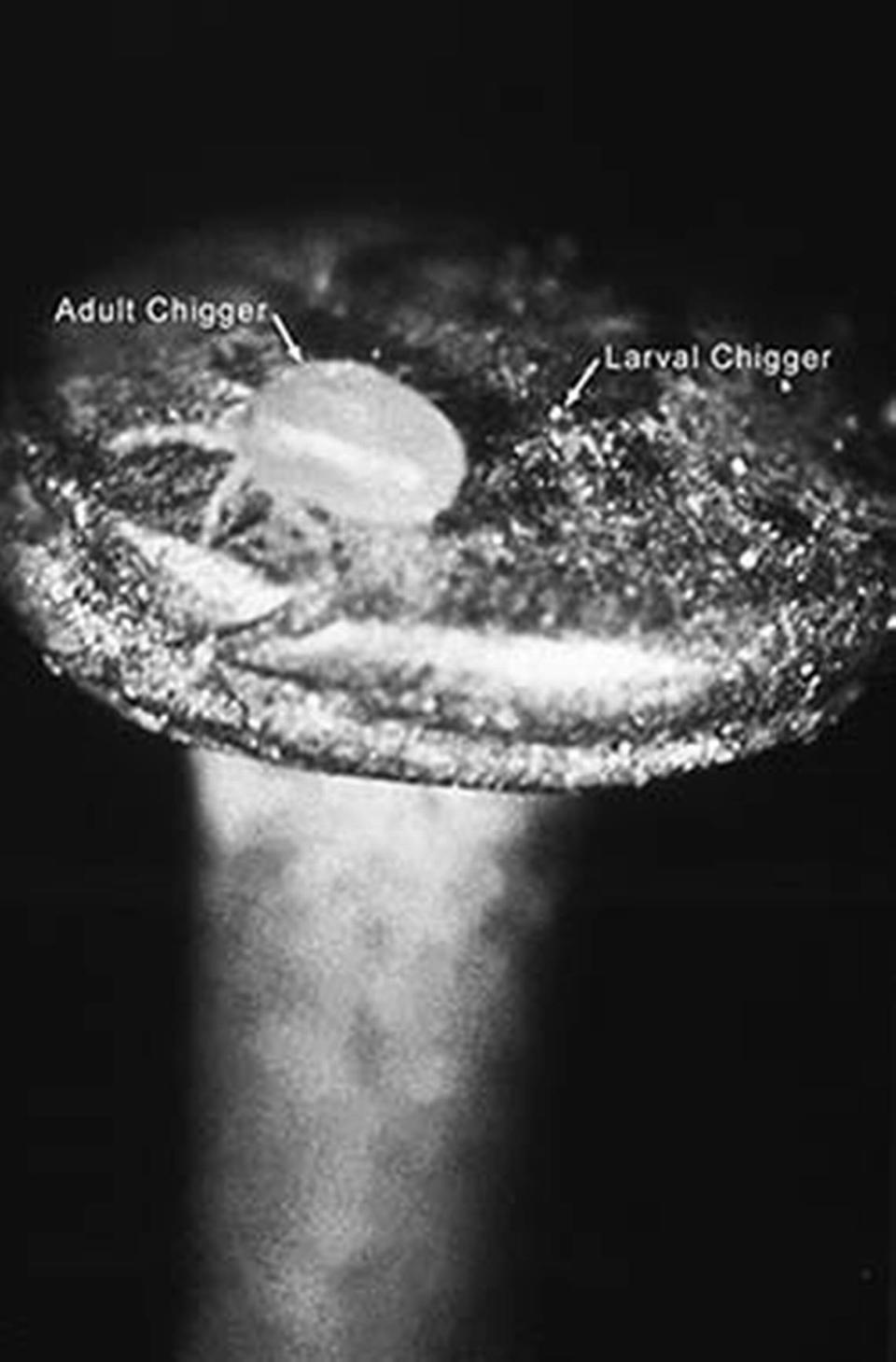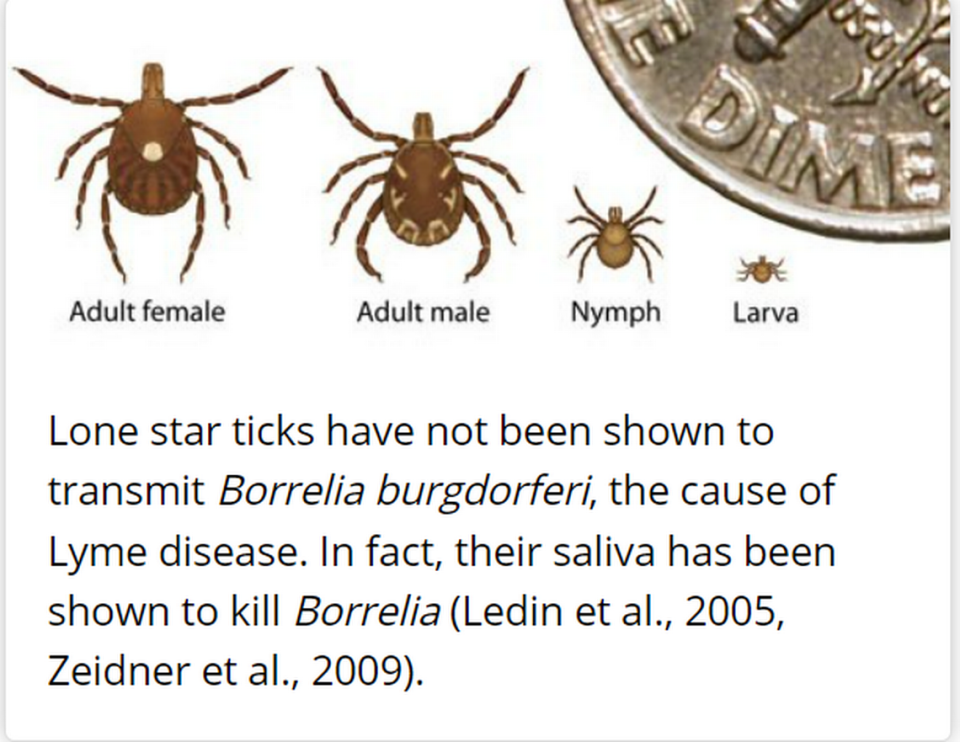It’s tick season. But another smaller, biting pest is lurking in your Kentucky yard
If you’ve ever done yard or garden work, only to later discover a line of itchy, red marks on your ankles and legs, you may have felt the pain of a brush with chiggers.
Also called berry bugs or harvest mites, chiggers are almost impossible to spot with the naked eye. In some parts of the world, they can also carry typhus, but in the U.S. these pests are little more than a nuisance.
To get at some of the most commonly asked questions about them, we spoke with a University of Kentucky entomologist. Here’s what to know, including tips for keeping them out of your backyard and ways to deal with their bites.
How do chiggers differ from ticks?
While chiggers and ticks are similar in that they’re arachnids, there are some differences.
For one, chiggers do not feed on human or animal blood as ticks do, and they like to travel around your body instead of attaching to one, well-hidden spot.
Instead of blood, chiggers are after your skin cells. They do this by releasing an enzyme to partially digest the cells before sipping them up. They then move on to another part of your skin to repeat the process.

Chiggers are also much harder to spot with the naked eye, unlike ticks, which are usually more visible. In Kentucky, some of the most common varieties of ticks are the deer tick, dog tick and the lone star tick.
Deer ticks spread Lyme disease and tick paralysis, and the greatest risk of encountering them occurs in the spring, summer and fall. However, you can encounter them any time winter temperatures are above freezing, according to the Kentucky Department of Fish and Wildlife Resources.
Dog ticks are reddish brown in color and unlike deer ticks, have a distinctive white-rimmed shield. This variety also spreads tick paralysis and spotted fever. Most active in the spring and summer, adult female dog ticks are the most likely to bite humans.
The lone star tick, taking over as the No. 1 most common tick species in Kentucky, has not been shown to carry Lyme disease. They can spread the emerging Heartland virus, which can lead to hospitalization and death in humans. This virus can cause alpha-gal syndrome, a serious allergic reaction to red meat. You’ll know a lone star tick by the single white dot on its back, which is exhibited by the female of the species.

It’s officially tick season in Kentucky. Here’s what you can do to protect yourself.
What does the chigger rash look like?
While it can vary from person to person, the telltale sign of chiggers on your skin will be red spots that can be flat or raised. They may look like blisters.
Chigger rashes most commonly show up on your ankles, behind the knees or at your waist level below your belt line. The arachnids gravitate toward the waist, armpits, chest area or anywhere an elastic band squeezes, such as a bra line or around the underwear.
According to Jonathan Larson, an assistant professor of entomology for the University of Kentucky’s Extension service, this is because it’s easier for them to go after their favorite food: your skin cells.

What’s the fastest way to get rid of chiggers? Do they burrow in your skin?
The fastest way to remove chiggers from your skin is by showering with soap and water. This washes off any that are still on your skin.
Chiggers do not breed in your home or bed, so you shouldn’t need to worry about an infestation, but you should probably toss your socks and pants in the wash to avoid reintroducing them to your skin.
Some people recommend using nail polish on the bites, but this isn’t an effective treatment, Larson said. You’re better off using some hydrocortisone or calamine lotion and taking an antihistamine.
Contrary to popular belief, chiggers do not burrow into the skin. According to Larson, they prefer to bite and move across your skin, leaving a line of ugly red welts or spots.
Chiggers are small, very small, so small you’d probably need a magnifying glass to see them clearly, according to Larson.
What draws chiggers to your yard?
If you grew up in Kentucky, or really anywhere in the South and Midwest where chiggers are most common, you might remember an outdoorsy family member pointing out a pretty, lace-like flower. They may have called it “chigger weed” or “chigger flower” and told you to avoid touching or playing around in it.
Known as Queen Anne’s lace or wild carrot, people often believe it to be a magnet for chiggers.
According to Larson, the entomologist, Queen Anne’s lace isn’t so much an attractor of chiggers, but more of a marker. A weedy yard covered with the plant and long grasses makes for an ideal habitat for chiggers, according to Larson.
“They do like more overgrown areas,” Larson told the Herald-Leader in a recent interview. “Keep that area mowed down.”
If you’ve been in any weedy or low-lying areas of your yard where humidity can gather, you should wipe down your feet and ankles with a wet towel, or better yet, take a quick shower and scrub them with soap.
Can you get rid of chiggers in your lawn?
Larson recommends treating your lawn with the insecticide bifenthrin, which is part of the pyrethroid family. You can typically find it in hardware stores or garden centers. According to the National Pesticide Information Center, this category of insecticides is made to mimic the pyrethrins refined from chrysanthemum flowers, where they occur naturally.
If you’d like to try an organic insecticide, you can try diatomaceous earth, which is recommended by some gardeners.
This silica dust crumbles insect exoskeletons and dries them out, killing them. It’s generally safe for plants, but you should avoid breathing it in or getting it on your skin, where it can cause irritation. Apply it after a rain, as getting diatomaceous earth wet cuts its effectiveness.
According to an article by University of Georgia entomologist Nancy Hinkle, chigger populations peak in the midsummer and stay high until the late fall. A hard freeze will kill them off.
How can you avoid getting chiggers while outdoors?
To avoid chiggers while working in your garden or backyard, wear long pants with the cuffs tucked into your socks or shoes and long sleeves.
Repellents that use DEET (chemical name N,N-diethyl-meta-toluamide), picaridin (which you can get as a lotion), IR-3535 and oil of lemon eucalyptus work best, according to Larson.
If you can, avoid working on warm afternoons and when the ground is between 77 and 86 degrees Fahrenheit. According to the Missouri Department of Conservation, this is when chiggers are most active.
When working outdoors for an extended period, or perhaps hiking in disturbed woods where trees have been cut down and there’s plentiful undergrowth, consider applying permethrin to your clothes.
As Larson explains in an article covering chiggers for UK Extension, “You can treat your clothing with permethrin. This is a true insecticide, so it shouldn’t be applied to the skin, but once it is dry on clothing, it will kill chiggers (as well as ticks and other pests) when they climb onto your clothing.”
Make sure to read the instructions carefully before using.
In the case of permethrin, apply in a well ventilated place, wait at least two hours for it to dry on your clothes and keep it well away from your pets, especially cats. Permethrin is highly toxic for cats and affects their central nervous system. It shouldn’t be harmful to cats when dry, but to be extra cautious and do not leave clothing treated with it where they can get to it.
Do you have a question about pests in Kentucky for our central service team? We’d like to hear from you. Fill out our Know Your Kentucky form or email ask@herald-leader.com.

